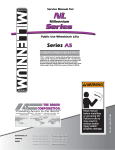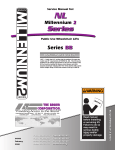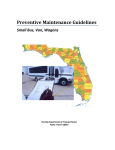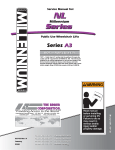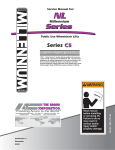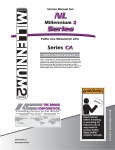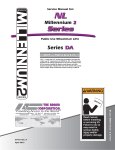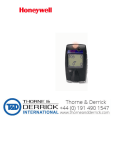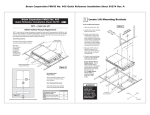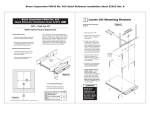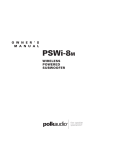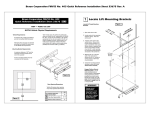Download Rev. H - Operator`s Manual - Commercial Wheelchair Lifts
Transcript
Operator's Manual for: WARNING Public Use Wheelchair Lifts Ope ra Man tor' ua s l DOT — Public Use Lift “DOT — Public Use Lift” verifies that this platform lift meets the “public use lift” requirements of FMVSS No. 403. This lift may be installed on all vehicles appropriate for the size and weight of the lift, but must be installed on buses, school buses, and multipurpose passenger vehicles other than motor homes with a gross vehicle weight rating (GVWR) that exceeds 4,536 kg (10,000 lb). International Corporate Hdqrs: P.O. Box 310 Winamac, IN 46996 USA (574) 946-6153 FAX: (574) 946-4670 1-800-THE LIFT ® 30651 Rev. H December 2009 ® ® Braun NL Series "Providing Access to the World" Read manual before operating lift. Failure to do so may result in serious bodily injury and/or property damage. Keep manual in lift storage pouch. Congratulations We at The Braun Corporation wish to express our fullest appreciation on your new purchase. With you in mind, our skilled craftsmen have designed and assembled the finest lift available. This manual includes safety precautions, lift operating instructions, manual operating instructions, and instructions for maintenance and lubrication procedures. Your lift is built for dependability, and will bring you years of pleasure and independence, as long as maintenance is performed regularly and the lift is operated by an instructed person. Sincerely, THE BRAUN CORPORATION Ralph W. Braun Chief Executive Officer Contents Warranty/Registration Instructions .................. 2, 3 Outer Barrier Latch ..................................... 20, 21 Lift Terminology Outer Barrier and Latch Operation ................... 21 Lift Terminology Illustration ........................................ 4 Bridging ............................................................. 21 Introduction ................................................................ 5 Handrails ........................................................... 21 Direction .................................................................... 5 Lift Passengers Lift Components .................................................... 6, 7 Passenger Orientation (Boarding Direction) ..... 22 Vehicle and Lift Interlocks ......................................... 7 Standees ........................................................... 22 Lift Actions and Functions .......................................... 8 Yellow Boundaries ...................................... 22, 23 Lift Operation Safety Vehicle (Floor Level) Loading and Safety Symbols ......................................................... 9 Unloading .................................................... 23, 24 Lift Operation Safety Precautions ...................... 10-13 Wheelchair-Equipped Occupant Seat Belts ........... 25 Operation Notes and Details Operation Procedure Review ........................... 25, 26 Introduction/Lift Access Doors and Interlocks ......... 14 Preventive Maintenance ......................................... 26 General Safety ......................................................... 15 Lift Operating Instructions ............................. 27-31 Control Switches ..................................................... 15 NHTSA Operations Checklist .............................. 32 Lift Features Manual Operating Instructions ....................... 33-37 Lift-Tite Latches™ ....................................... 16, 17 Decals and Antiskid ........................................ 38-40 Inner Roll Stop ............................................ 18, 19 Maintenance and Lubrication ......................... 41-49 Outer Barrier ............................................... 19, 20 Limited Warranty .............................................. 50-57 Page 1 Warranty and Registration Instructions Immediately upon receiving your lift, examine the unit for any damage. Notify the carrier at once with any claims. Two warranty/registration cards (shown below) are located in the pump cover owner's manual storage pouch. The sales representative must process one of the cards. The consumer must fill out the other card and mail it to The Braun Corporation. The warranty is provided on the back cover of this manual. The warranty cards must be processed to activate the warranty. Two Braun Serial No./Series No. identification tags are posted on the lift. One I.D. tag (shown below) is posted on the opposite pump side vertical arm. A second I.D. tag is located on the opposite pump side tower. Both I.D. tags provide the product identification information appearing on the Warranty/Registration card. Record the information in the space provided on the next page. This information must be provided when filing a warranty claim or ordering parts. The Braun Corporation Series No. Pump Code Model No. Serial No. Cylinder Code 1-800-THE LIFT™ BRAUNLIFT.COM™ DOT Public Use Lift MODEL# NL917IB Max. Lifting Capacity - 800 lbs. OWNER'S WARRANTY REGISTRATION SERIAL NUMBER 01-00025 NL917IB-04-02730-56-14CG PUMP CODE PURCHASED FROM 10/24/04 DATE INSTALLED NAME ADDRESS CITY STATE ZIP TO VALIDATE WARRANTY REGISTRATION CARDS MUST BE RETURNED TO THE BRAUN CORPORATION. Page 2 14CG MFG DATE OWNER TELEPHONE CYLINDER 56 Sample Warranty/Registration Card Sample Serial No./Series No. Identification Tag e5*72/245*95/54*0110*00 PATENT PENDING- 5,261,779-6,065,924-6,238,169-6,46 4,447-6,599,079-6,692,217-6,739,824 Warranty and Registration Instructions Model No. Pump Code Series No. Cylinder Code Serial No. Date of Manufacture Note: This information must be provided when filing a warranty claim or ordering parts. Keep for future use. Page 3 32819 N DOW UP OLD UNF D FOL 32820 Visual Threshold Warning Lift-Tite™ Latches (2) Towers (2) Top Parallel Arms (2) Main Cylinders (2) Unfold Assist Compression Springs (2) Audible Threshold Warning Adjustable Quiet-Ride Stow Blocks (2) Platform Lights Opposite Pump Side Vertical Arm Vertical Arm Covers (4) Hand-Held Pendant Control Handrails (2) Threshold Warning Plate Pump Module Lift Terminology Illustration Base Plate Inner Roll Stop Bottom Parallel Arms (2) Inboard Rotating Pivot Slide Arms (2) Platform Pivot Arms (2) Platform Left Right Outboard Pump Side Vertical Arm Outer Barrier Cylinder (not visible -underside of platform) Platform Side Plates (2) Outer Barrier Latch Page 4 Outer Barrier (Automatic Outboard Roll Stop) Lift Terminology Introduction: Braun NL Millennium Series lifts are ADA compliant and comply fully with National Highway Traffic Safety Administration (NHTSA) specifications. The NL is commercial oriented (intended for operation by an attendant). Lift models vary per size (lift model numbers indicate lift dimensions). NL Series lift models can be equipped with left or right side pump modules as needed. A left side pumpequipped lift model is depicted in the Lift Terminology Illustration (NL917IB). Right side pump lift models are a mirrored image of rear pump models (pump module located on opposite end of base plate). Refer to the Lift Terminology Illustration for identification of lift components. Lift operation procedures are identical for all NL Series lift models. The operating instructions contained in this manual and appearing on liftposted operating instructions decals address the lift control switches and the corresponding lift functions. Instructions are provided for manual operation of the lift in event of power or equipment failure. Terminology: Become familiar with the terminology that will be used throughout this manual. Become familiar with the identification of lift components and their functions. Contact your lift sales representative or call The Braun Corporation at 1-800-THE LIFT® if any of this information is not fully understood. Direction: The terms "left," "right," "inboard," and "outboard" will be used throughout this manual to indicate direction (as viewed from outside the vehicle looking directly at the lift). Refer to the Lift Terminology Illustrations for clarification of direction terms. Page 5 Lift Terminology Lift Components Refer to the Lift Terminology Illustration on page 4. Pump Module: The lift-mounted pump module consists of the hydraulic pump, the manual hand pump, the electronic control board and electrical components that power the lift electric/hydraulic systems. Hand-held Pendant Control: The hand-held attendant's pendant control is connected to the pump module. The handheld pendant is equipped with two rocker switches, (UNFOLD, FOLD, DOWN, and UP). The momentary switches activate the automatic lift functions. Page 6 Lift Frame: The lift frame consists of the base plate, threshold warning plate, towers, parallel arms, vertical arms, platform pivot arms and handrails. Two main hydraulic cylinders are housed in the parallel arms. The electrical/hydraulic powered lift frame components mechanically unfold, lower, raise and fold the lift platform assembly. Platform Assembly: The platform assembly consists of the steel tubing frame with grating surface upon which the wheelchair is positioned, the outer barrier, outer barrier latch, the inner roll stop, and the hydraulic cylinder assembly that powers the outer barrier. Lift-Tite™ Latches: The springloaded latches prevent the platform from unfolding from the stowed position in the event of platform drift. Further details regarding Lift-Tite™ latches are provided on pages 16 and 17. Outer Barrier: The cylinderpowered automatic outer barrier provides a ramp for wheelchair loading and unloading at ground level. Photos and further details regarding the outer barrier are provided in the Operation Notes section (pages 19-21). Outer Barrier Latch: The springloaded latch locks the outer barrier in the vertical position when the platform raises above ground level. Lift Terminology Inner Roll Stop: NL Series lift models are equipped with an automatic inboard roll stop that also serves as the bridge plate. The roll stop bridges the gap between the lift platform and the vehicle floor. The inner roll stop automatically rotates from the horizontal position to the vertical position as the lift lowers and raises. Further details regarding the automatic mechanical inboard roll stop are provided on pages 18 and 19. Vehicle and Lift Interlocks Braun Corporation NL917IB Series lifts comply fully with all NHTSA vehicle and lift interlock specifications. Vehicle movement is prohibited unless the lift is fully stowed and the lift will not function unless the vehicle is parked and secured. The NL features a visual and audible threshold warning system that will activate if the threshold area is occupied when the platform is one inch or more below floor level. the outer barrier are occupied. The lift platform cannot be folded (stowed) if occupied. The inner roll stop features a locking mechanism that prohibits the platform from lowering if the lock does not engage. The lift platform cannot be raised more than 3" above ground level unless the outer barrier is in the vertical position and the outer barrier latch is positively engaged. The inner roll stop and outer barrier sense weight to prohibit lift operation. The lift will not function if the inner roll stop or Page 7 Lift Terminology Lift Actions and Functions DEPLOY (A-C) A. UNFOLD (Out) - Platform Unfold: Unfold is the action of the platform rotating out and down from the fully-stowed (vertical) position to floor level (horizontal) position when the UNFOLD switch is pressed. B. DOWN - Platform Lower: Down is the action of the platform lowering from floor level position to fully-lowered (ground level) position when the DOWN switch is pressed. C. DOWN - Outer Barrier Unfold (Deploy) - When the platform reaches the fully-low- Page 8 ered (ground) position and the DOWN switch is continued to be pressed, the outer barrier rotates downward from vertical position to ramp position. F. FOLD (In) - Platform Fold: Fold is the action of the platform rotating up and in from the floor level (horizontal) position to fullystowed (vertical) position when the FOLD switch is pressed. STOW (D-F) D. UP - Outer Barrier Fold (Raise): When the lift is fully lowered and the outer barrier is in the ramp position, pressing the UP switch first rotates the outer barrier upward from ramp position to vertical position. E. UP - Platform Raise: Up is the action of the platform raising from ground level to floor level (fully-raised) position when the UP switch is pressed. Stowed Position: The lift is stowed when the lift platform has been fully raised and folded fully (vertical position). Floor Level: Floor level is the position (height) the platform assembly reaches in order for the wheelchair passenger to enter and exit the vehicle (fully raised). The platform automatically stops at floor level when unfolding from the stowed position and when raising from ground level. Lift Operation Safety Safety Symbols SAFETY FIRST! Know That.... All information contained in this manual and supplements (if included), is provided for your safety. Familiarity with proper operation instructions as well as proper maintenance procedures are necessary to ensure safe, troublefree operation. Safety precautions are provided to identify potentially hazardous situations and provide instruction on how to avoid them. A D B WARNING This symbol indicates important safety information regarding a potentially hazardous situation that could result in serious bodily injury and/or property damage. C CAUTION This symbol indicates important information regarding how to avoid a hazardous situation that could result in minor personal injury or property damage. Note: Additional information provided to help clarify or detail a specific subject. These symbols will appear throughout this manual as well as on the labels posted on your lift. Recognize the seriousness of this information. Page 9 Lift Operation Safety Lift Operation Safety Precautions WARNING If the lift operating instructions, manual operating instructions and/or lift operation safety precautions are not fully understood, contact The Braun Corporation immediately. Failure to do so may result in serious bodily injury and/or property damage. WARNING Read manual and supplement(s) before operating lift. Read and become familiar with all safety precautions, operation notes and details, operating instructions and manual operating instructions before operating the lift. Note: Wheelchair passengers and all transit agency personnel (drivers and wheelchair lift attendants) must read and become familiar with the contents of this manual and supplement(s) before operation. WARNING Load and unload on level surface only. WARNING Engage vehicle parking brake before operating lift. WARNING Provide adequate clearance outside the vehicle to accommodate the lift before opening lift door(s) or operating lift. WARNING Inspect lift before operation. Do not operate lift if you suspect lift damage, wear or any abnormal condition. WARNING Keep operator and bystanders clear of area in which the lift operates. Page 10 Lift Operation Safety WARNING Whenever a wheelchair passenger (or standee) is on the platform, the: • Passenger must be positioned fully inside yellow boundaries • Wheelchair brakes must be locked • Inner roll stop and outer barrier must be up (vertical) • Outer barrier latch must be fully engaged • Passenger should grip both handrails (if able). WARNING Load and unload clear of vehicular traffic. WARNING Do not overload or abuse. The load rating applies to both the raising and lowering functions - continuous lifting capacity is 800 lbs. WARNING Discontinue lift use immediately if any lift or vehicle interlock does not operate properly. WARNING Do not operate or board the lift if you or your lift operator are intoxicated. WARNING Do not raise front wheelchair wheels (pull wheelie) when loading (boarding) the platform. WARNING Open lift door(s) fully and secure before operating lift. WARNING Position and secure (buckle, engage, fasten, etc.) the wheelchair-equipped occupant seat belt (torso restraint) before loading onto the wheelchair lift platform. Page 11 Lift Operation Safety Lift Operation Safety Precautions (continued) WARNING If the lift operating instructions, manual operating instructions and/or lift operation safety precautions are not fully understood, contact The Braun Corporation immediately. Failure to do so may result in serious bodily injury and/or property damage. WARNING Lift attendants must ensure that lift occupants keep hands, arms and all other body parts within the lift occupant area and clear of moving parts. WARNING Platform must be positioned at floor level (roll stop height) when loading or unloading in and out of vehicle. WARNING Do not use platform inner roll stop or outer barrier as a brake. Stop and brake wheelchair when loading onto the platform (manually stop and brake manual wheelchairs — stop powered wheelchairs with the wheelchair controls). WARNING Turn powered (electric) wheelchairs off when on lift platform. WARNING Press the DOWN switch until the entire platform rests on ground level (lowered fully) and the outer barrier is fully unfolded (ramp position) before loading or unloading a passenger at ground level. WARNING Outer barrier must be fully unfolded (ramp position) until front and rear wheelchair wheels cross the barrier when loading or unloading at ground level. Page 12 Lift Operation Safety WARNING Accidental activation of control switch(es) may cause unintended operation(s). WARNING Maintenance and lubrication procedures must be performed as specified in this manual by authorized (certified) service personnel. WARNING Replace missing, worn or illegible decals. WARNING Keep owner’s (operator's) manual in lift-mounted manual storage pouch at all times. WARNING Never modify (alter) a Braun Corporation lift. WARNING Do not use accessory devices not authorized by The Braun Corporation. WARNING Do not remove any guards or covers. WARNING Keep clear of any hydraulic leak. WARNING Failure to follow these safety precautions may result in serious bodily injury and/or property damage. Page 13 Operation Notes and Details WARNING Read and become familiar with all lift operation safety precautions, operation notes and details, operating instructions and manual operating instructions prior to operating the lift. If this information is not fully understood, contact The Braun Corporation immediately. Failure to do so may result in serious bodily injury and/or property damage. Page 14 NL Series “Public Use” lift models are specifically designed to be operated by an attendant. The Lift Operating Instructions contained in this manual and posted on the lift provide instructions for operation of the lift only. Read and become familiar with all lift operation safety precautions, operation notes and details, operating instructions and manual operating instructions before attempting lift operation procedures. Instructions for operation of vehicle interlocks and door securement systems are not addressed in this manual or on lift-posted operating instructions decals due to the variety of procedures required for operating them. Braun Corporation NL Series lifts comply fully with all NHTSA vehicle and lift interlock specifications (detailed on pages 7 and 32). Infringement of any lift interlock will prohibit lift operation. Lift Access Doors and Interlocks: Attendants must become familiar with the vehicle lift access door system and vehicle interlock system(s). Transit vehicles and lift access door configurations vary. Door securement devices (latches, hooks, cables, etc.) and procedures to operate them vary. It is the responsibility of the lift operator (attendant) to properly open, secure and close the vehicle lift door(s), to activate the vehicle interlock(s), to load and unload the wheelchair passenger (or standee) on and off the lift platform, and to properly activate all lift functions. Operation Notes and Details General Safety: The lift operator (attendant) and bystanders must keep clear of the area in which the lift operates and clear of all moving parts. Lift attendants must ensure that lift occupants (passengers) keep hands, arms and all other body parts within the lift occupant area and clear of moving parts. Control Switches Lift Power ON/OFF Switch: This switch must be in the ON position in order to activate the lift. The green Power Indicator Light mounted on top of the pump module illuminates to signal power to the lift. Hand-held Pendant Control: The hand-held attendant's pendant control is equipped with two rocker switches, (UNFOLD, FOLD, DOWN, and UP). The momentary switches activate the automatic lift functions. Hand-held Pendant Simply press the switch labeled for the intended function. Page 15 Operation Notes and Details Lift Features Become familiar with all lift features and the proper operation of the lift components before attempting lift operation. Refer to the Lift Terminology Illustrations for identification of specific lift components if not clearly depicted in this section. Contact The Braun Corporation at 1-800-THE LIFT® immediately if any of this information is not understood. Lift-Tite™ Latches: NL Series lifts are equipped with Lift-Tite™ Latches. Lift-Tite™ Latches pre- Latch Engagement Pin (Roller) WARNING Discontinue lift use immediately if any lift component does not operate properly. Failure to do so may result in serious bodily injury and/or property damage. Page 16 Engaged Lift-Tite™ Latch Operation Notes and Details vent the platform from unfolding from the stowed position in the event of platform drift. Due to the “all-hydraulic” operation of the dual-cylinder NL, hydraulic fluid expansion, contraction or seepage may occur. Any of these conditions may result in platform drift (failure to hold the platform in the folded or raised position). Platform drift may occur during lift shipment and/or between extended periods of non-lift use. In the event that the platform does not unfold when the UNFOLD switch is pressed, press the FOLD switch momentarily to disengage the Lift-Tite™ latches (platform drift has occurred). Then, press the UNFOLD switch to unfold the platform to floor level (standard operation). When manually operating a lift equipped with Lift-Tite™ latches, insert the pump handle in the pump and stroke until the platform folds fully (stops). Then, open the hand pump valve (turn counterclockwise) to unfold the platform. Folding the platform fully first will ensure that the Lift-Tite™ latches will disengage properly when the release valve is opened. Manual Operating Instructions are provided on pages 33-37. Disengaged Lift-Tite™ Latch Latch Engagement Pin (Roller) Page 17 Operation Notes and Details Lift Features (continued) Inner Roll Stop: NL Series lift models are equipped with an automatic inner roll stop that also serves as the bridge plate (inner roll stop photos below). When the UNFOLD switch is pressed and the platform unfolds from stow position to floor level, this mechanical roll stop is automatically deployed to the bridging (horizontal) position to provide a bridge plate between the platform and the lift base plate (vehicle floor). The inboard edge of the bridge plate rests on the threshold warning plate (base plate). Fully-Deployed Fully-Unfolded (vertical) (horizontal) Inner Inner Roll Stop Roll Stop (bridging position) Inner Roll Stop The inner roll stop must overlap the base plate a minimum 1/2". Page 18 The roll stop automatically folds (rotates) to the vertical (roll stop) position when the platform lowers to the ground (DOWN switch is pressed). As the UP switch is pressed and the platform raises from ground level, the inner roll stop automatically unfolds (rotates) to the Operation Notes and Details WARNING Discontinue lift use immediately if any lift component does not operate properly. Failure to do so may result in serious bodily injury and/or property damage. horizontal (bridging) position when it reaches vehicle floor level. The roll stop must overlap the lift base plate a minimum 1/2". When the FOLD switch is pressed and the platform folds from floor level to the stow (vertical) position, the roll stop auto- matically travels inboard to the stowed position. Interlock Features: The inner roll stop features a locking mechanism that prohibits the platform from lowering if the lock is not engaged. The inner roll stop also senses weight to prohibit lift operation. The lift will not function if inner roll stop is occupied. Discontinue lift operation immediately if the inner roll stop does not operate properly. Outer Barrier: This cylinder-powered barrier provides a ramp for wheelchair loading and unloading at ground level (see photos on following page). When the platform lowers fully to ground level, the cylinder compression spring automatically unfolds (rotates) the barrier to the ramp position (fully unfolded). Although the outer barrier is lift-powered, the activation of the barrier is controlled by the lift operator (attendant). Pressing the DOWN switch unfolds the barrier. The outer barrier is cylinder-powered to automatically fold (rotate) to the vertical position as shown when the UP switch is pressed (barrier raises before platform raises). Interlock: The outer barrier senses weight to prohibit lift operation. The lift will not function if the outer barrier is occupied. Page 19 Operation Notes and Details Lift Features (continued) Discontinue lift operation immediately if the outer barrier does not operate properly. Outer Barrier Latch: A springloaded latch engages the outer barrier when the barrier rotates upward from ramp position to the vertical position (UP switch is pressed to raise the platform above ground level). Note: The platform must raise approximately three inches before the latch engages fully (see photos on Fully-Folded Outer Barrier (Up-vertical) Disengaged Outer Barrier Latch Outer Barrier Latch Foot Page 20 Interlock: Lift platform movement shall be interrupted unless the outer barrier is raised (vertical position) and the outer barrier latch is positively engaged. Fully-Unfolded Barrier (Ramp position) Fully-Engaged Outboard Barrier Latch 3" previous page). Note: Platform must raise approximately three inches before latch engages fully. Operation Notes and Details The latch disengages the barrier when the platform lowers fully (reaches ground level) and the latch foot contacts the ground (latch raises above the barrier). Outer Barrier and Latch Operation: The lift attendant must press the DOWN switch to lower the platform fully to the ground. The attendant must view the platform as it lowers to be certain the entire platform reaches and rests safely on the ground. Stop pressing the DOWN switch if any portion of the platform is obstructed while descending or the entire platform does not reach ground level for any reason (contact with an obstruction, mechanical failure, exceeding the lift “floor-to-ground” capacity, etc.). After the platform is fully lowered, the attendant should continue to press the DOWN switch to unfold the outer barrier fully (ramp position). Note: The barrier must be fully unfolded until the entire wheelchair (or standee) has crossed the barrier when loading or unloading at ground level. Discontinue lift operation immediately if the outer barrier or latch do not operate properly. Bridging: The NL incorporates a bridging feature. This feature stops the down travel of the platform if the outboard end of the platform contacts a raised surface (such as a curb), preventing the operator from lowering the inboard end of the platform. Handrails: Dual handrails are provided for wheelchair passenger (or standee) use. The handrails unfold automatically to the deployed (horizontal) position when the lift unfolds and automatically fold to the stowed (vertical) position when the platform folds. If able, passengers should grip both handrails when on the lift platform. Discontinue lift operation immediately if the handrails do not operate properly. Page 21 Operation Notes and Details Lift Passengers If you are an attendant operating the lift, it is your responsibility to perform safe loading and unloading procedures. Wheelchair lift attendants should be instructed on any special needs and/or procedures required for safe transport of wheelchair passengers. The lift operator and bystanders must keep clear of the area in which the lift operates. Observe your passenger at all times during lift operation. Do not attempt to load or unload a passenger in a wheelchair or other apparatus that does not fit on the platform area. Do not exceed the 800 pound load capac- Page 22 ity of the lift. The lift attendant should not ride on the platform with the passenger. Passenger Orientation (Boarding Direction): Braun NL Series wheelchair lifts accommodate both inboard and outboard facing wheelchair passengers or standees. Inboard facing of wheelchair lift passengers is not prohibited, but outboard facing of passengers is recommended by The Braun Corporation. Braun NL Series lifts permit both inboard and outboard facing of wheelchair and mobility aid users and accommodate persons using walkers, crutches, canes or braces or who otherwise have difficulty using steps. Standees: Lift Operating Instructions apply to wheelchair passengers and standees. Standees should stand in the center of the platform (fully inside the yellow boundaries) and grip both handrails (if able) when on platform. Yellow Boundaries: The passenger must be positioned in the center of the platform to prevent side-to-side load imbalance. The lift attendant (operator) should not ride on the platform with the passenger. Yellow platform loading boundaries are identified in the following manner. The yellow powdercoated inner roll stop and outer barrier identify the inboard and outboard ends of the platform. A yellow powder-coated guard is lo- Operation Notes and Details cated on the pump-side platform side plate. A yellow boundary strip decal is affixed to the opposite platform side plate. Yellow plastic caps are placed on the dual handrails. The threshold warning plate is powder-coated yellow to identify the platform threshold area. Interlock: A visible and audible threshold warning system will activate if the threshold area is occupied when the platform is one inch or more below floor level. The attendant must always be certain the wheelchair passenger or standee is properly positioned on the platform (fully inside yellow boundaries) and the wheelchair brakes are locked when a passenger is on the lift platform. The lift passenger must keep hands, arms and all other body parts within the lift occupant area and clear of all moving parts. Vehicle (Floor Level) Loading and Unloading: The platform must be fully raised (at floor level) and the bridge plate must be properly positioned when loading or unloading passengers in or out of the vehicle. It is the responsibility of the lift attendant to ensure the platform and the bridge plate are properly positioned at floor level when loading and unloading passengers. WARNING Whenever a passenger is on the platform, the: • Passenger must be positioned fully inside yellow boundaries • Wheelchair brakes must be locked • Inner roll stop and outer barrier must be UP Failure to follow these rules may result in serious bodily injury and/or property damage. Page 23 Operation Notes and Details Lift Passengers (continued) The wheelchair brakes must be locked, the outer barrier must be in the fully-up (vertical) position and the outer barrier latch must be fully engaged whenever a passenger is on the platform. Do not use the outer barrier as a brake. Stop and brake the wheelchair when fully loaded on the platform. Manually stop and brake manual wheelchairs. Stop powered wheelchairs with the wheelchair controls. Turn powered (electric) wheelchairs off when on the platform. If the outer barrier, inner roll stop, handrails or any other lift component does not operate as Page 24 outlined in this manual, discontinue lift use immediately and contact The Braun Corporation sales representative in your area or call The Braun Corporation at 1-800-THE LIFT®. One of our national Product Support representatives will direct you to an authorized service technician who will inspect your lift. WARNING Discontinue lift use immediately if any lift component does not operate properly. Failure to do so may result in serious bodily injury and/or property damage. Operation Notes and Details Wheelchair-Equipped Occupant Seat Belts The Braun Corporation recommends wheelchair passengers position and buckle their wheel- WARNING Position and secure (buckle, engage, fasten, etc.) the wheelchair-equipped occupant seat belt before loading onto the wheelchair lift platform. Failure to do so may result in serious bodily injury and/or property damage. chair-equipped seat belt (torso restraint) before loading onto a wheelchair lift. Different types of disabilities require different types of wheelchairs and different types of wheelchair-equipped occupant restraint belt systems (torso restraints). It is the responsibility of the wheelchair passenger to have his or her wheelchair equipped with an occupant restraint (seat belt) under the direction of their health care professional. Wheelchair lift attendants should be instructed on any special needs and/or procedures required for safe transport of wheelchair passengers. Operation Procedure Review The Braun Corporation recommends that transit agency supervisors and wheelchair lift attendants review the safety precautions and operation procedures appearing in this manual and on lift-posted decals with your wheelchair lift sales representative (dealer), before attempting lift operation. Any questions or concerns can be addressed by the sales representative at that time. Operate the lift through all functions with your sales representative on hand to ensure the proper use and operation of the wheelchair lift is understood. Page 25 Operation Notes and Details Transit agency supervisors should train and educate their lift attendants on the proper use and operation of the wheelchair lift if it is not possible for the attendants to review the safety precautions and operation procedures with the wheelchair lift sales representative. The lift operator's manual must be stored in the lift-mounted manual storage pouch at all times. Preventive Maintenance: Maintenance is necessary to ensure safe and troublefree lift operation. General preventive lift maintenance consisting of careful inspections of the lift system and cleaning the lift should Page 26 be a part of your transit agency's daily lift service program. Simple inspections can detect potential lift operational problems. Regular preventive maintenance will reduce potential lift operation downtime and increase the service life of the lift, as well as possibly detecting potential hazards. Exposure to harsh weather elements, environmental conditions, or heavy usage may require more frequent maintenance and lubrication procedures. Preventive maintenance visual inspections do not take the place of the procedures specified in the Maintenance and Lubrication Schedule provided on pages 41- 49 of this manual. Refer to the Maintenance and Lubrication section for further details. WARNING Maintenance and lubrication procedures must be performed by authorized service personnel as specified in this manual. Failure to do so may result in serious bodily injury and/or property damage. Lift Operating Instructions WARNING Read and become familiar with all lift operation safety precautions, operation notes and details, operating instructions and manual operating instructions prior to operating the lift. If this information is not fully understood, contact The Braun Corporation immediately. Failure to do so may result in serious bodily injury and/or property damage. WARNING Whenever a passenger is on the platform, the: • Passenger must be positioned fully inside yellow boundaries • Wheelchair brakes must be locked • Inner roll stop and outer barrier must be UP Failure to follow these rules may result in serious bodily injury and/or property damage. Before lift operation, park the vehicle on a level surface, away from vehicular traffic. Place the vehicle transmission in "Park" and engage the parking brake. Vehicle engine must be running. Lift Operating Instructions photos depict lift model NL917IB. Instructions and procedures are applicable for all NL Series lift models. Lift-posted Warnings and Lift Operating Instructions decal 30695 provides lift operating instructions. Replace any missing, worn or illegible decals. If your lift does not function as intended a visual or audible warning signal is activated, review the NHTSA Operations Checklist on page 32. Follow the Manual Operating Instructions on pages 33-37 to manually operate lift. Page 27 Lift Operating Instructions Open Door(s) and Secure To Unfold Platform: Stand clear and press the UNFOLD switch until the platform stops (reaches floor level - unfolds fully). Release switch. Note: In event platform does not unfold, press FOLD switch to release Lift-Tite™ latches. To Unload Passenger: 1. Read Note below! Load passenger onto platform and lock wheelchair brakes. Note: Passenger must be positioned fully inside yellow boundaries, outer barrier must be UP and outer barrier latch must be engaged. Page 28 Lift Operating Instructions A To Unload Passenger (continued): B 2. Press DOWN switch until the entire platform reaches ground level (see Photo B) and the outer barrier unfolds fully (ramp position). See Photo C. Release switch. 3. Unlock wheelchair brakes and unload passenger from platform. Note: Outer barrier must be fully unfolded (ramp position) until the entire wheelchair (or standee) has crossed the outer barrier. See Photos E and F on page 30 also. C D Page 29 Lift Operating Instructions E To Load Passenger: F 1. Read Notes below! Load passenger onto platform and lock wheelchair brakes. See Photo G. G Note: Outer barrier must be fully unfolded (ramp position) until the entire wheelchair (or standee) has crossed the outer barrier. See Photos E and F. Note: Passenger must be positioned fully inside yellow boundaries. H Page 30 Lift Operating Instructions I To Load Passenger (continued): J 2. Press UP switch (Photo I) to fold outer barrier UP fully (vertical - see Photo H), and raise the platform to floor level. See Photo J. Release switch. 3. Unlock wheelchair brakes and unload passenger from platform. K To Fold Platform: L Press FOLD switch until platform stops (fully folded). See Photos K and L. Release switch. Close Door(s) Page 31 NHTSA Operations Checklist The following operations have been verified upon installation. This operational checklist can be used at any time to verify the lift is fully functional. Verified: Vehicle movement is prevented unless the lift door is closed, ensuring the lift is stowed. Lift operation shall be prevented unless the vehicle is stopped and vehicle movement is prevented. The platform will not fold/stow if occupied. Platform movement is prohibited beyond the position where the inner roll stop is fully deployed (up). Platform movement shall be interrupted unless the outer barrier is deployed (up). WARNING Discontinue lift use immediately if any lift or vehicle interlock does not operate properly. Failure to do so may result in serious bodily injury and/or property damage. The inner roll stop will not raise if occupied. The outer barrier will not raise if occupied. Verify platform lighting* when lift is deployed and pendant illumination when lift is powered. A visual and audible warning will activate if the threshold area is occupied when the platform is at least one inch below floor level. Page 32 *Public use vehicle manufacturers are responsible for complying with the lift lighting requirements in Federal Motor Vehicle Safety Standard No. 404, Platform Lift Installations in Motor Vehicles (49 CFR 571.404). Manual Operating Instructions Instructions and photos are provided for all steps that differ from standard lift operation procedures. The Manual Operation decal (posted inside pump cover) provides manual operating instructions also. Note: Inner roll stop and outer barrier automatically function during manual operations. Note: A right side pump lift model is depicted in the photos. Left side pump applications are a mirrored image. Refer to the Lift Operating Instructions for all normal lift operation procedures. Follow all Lift Operation Safety Precautions! Turn wing 1/4 turn. Rotate top clip to access handle. Pump Cover Hand Pump Handle Lock Unlock Page 33 Manual Operating Instructions Remove the pump cover to gain access to the pump handle and the hand pump. See photos on page 33. A Hand Pump To remove the pump cover, turn the wing nut located on top 1/4 turn and lift the pump cover off. Release Valve The pump handle is inside this cover secured by two clips. Rotate the top clip to remove the pump handle. approximate 1/16" intervals maximum 30 inch lbs Valve Tightening Specification: Once valve seats (stops), tighten 15 to 30 inch pounds as shown. minimum 15 inch lbs Note: Close backup pump release valve securely before operating electric pump. Page 34 OSE CL OPEN seats (stops) Release Valve Manual Operating Instructions Remove pump cover to access hand pump and pump handle as outlined on page 33. Refer to release valve photos and illustration on page 34. To Unfold Platform (Out): Using hand pump handle (Photo B): 1. Close hand pump valve (place slotted end of pump handle onto backup pump release valve and turn clockwise). Down (To Lower): Place slotted end of pump handle onto backup pump release valve and turn counterclockwise (open 1/2 turn only) until the platform reaches ground level and roll stop unfolds. 2. Insert handle in pump and stroke until platform folds fully (stops). Open (Down) Close (Up/Stop) 3. Open hand pump valve (turn counterclockwise) until platform reaches floor level. Open 1/2 turn only. 4. Close hand pump valve (turn clockwise). Note: Valve must be tight, but do not overtighten. B Stroking Hand Pump C Page 35 Manual Operating Instructions Remove pump cover to access hand pump and pump handle as outlined on page 33. Refer to release valve photos and illustration on page 34. Open Close (Down) (Up/Stop) Up (To Raise): Using hand pump handle: 1. Place slotted end of pump handle onto backup pump release valve and turn clockwise to close securely. See Photo D. 2. Insert handle into backup pump and stroke until platform reaches floor level (see Photo E). Insert handle into backup pump and stroke until platform stops (folds fully). See Photo E. Page 36 Store pump handle and install pump cover as outlined on page 37. Note: Valve must be tight, but do not overtighten. To Fold Platform (In): D Note: Close backup pump release valve securely before operating electric pump. Stroking Hand Pump E Manual Operating Instructions To Store Pump Handle: 1. Insert bottom of handle behind bottom clip. See page 33. 2. Rotate top clip to secure (lock) handle. To Install Pump Cover: 1. Position cover over module back cover and red warning light. See Photo F. 2. Align outside cover lip with bottom cover offset and insert outside cover. See Photo G. 3. Insert wing stud and rotate 1/4 turn to lock cover. See Photo H. Position cover over red light. Align and insert bottom of cover. Lock Unlock F G H Page 37 Decals and Antiskid Note: Clean surfaces as detailed on page 40 before posting decals. 33221 29052 MANUAL OPERATION 25675 Page 38 TO UNFOLD PLATFORM: TO UNFOLD PLATFORM (OUT): Stand clear and press UNFOLD switch until platform stops (reaches floor level). LIFT POWER ON 1. Load passenger onto platform and lock wheelchair brakes. 2. Press DOWN switch until entire platform reaches ground level and outer barrier unfolds fully. 3. Unlock wheelchair brakes and unload passenger from platform. OPEN UP (TO RAISE): CLOSE 1. Close hand pump valve (turn clockwise). 2. Insert handle in pump and stroke until platform reaches floor level. Read warnings and operate lift as outlined on LIFT OPERATING INSTRUCTIONS decal. Lift operating instructions apply to wheelchair passengers and standees. TO LOAD PASSENGER: 1. Load passenger onto platform and lock wheelchair brakes. 2. Press UP switch to fold outer barrier up and raise platform to floor level. 3. Unlock wheelchair brakes and unload passenger from platform. TO FOLD PLATFORM (IN): Insert handle in pump and stroke. Note: Close valve before operating electric pump. Standees: Standees must stand at center of platform (fully inside yellow boundaries), grip handrails and lower head. TO STORE PUMP HANDLE: TO FOLD PLATFORM: 1. Insert bottom of handle behind bottom clip. 2. Rotate clip to lock. Press FOLD switch until platform stops. Release switch. CLOSE DOOR(S) DOT — Public Use Lift DOT — Public Use Lift 21494 TO UNLOAD PASSENGER: VALVE DOWN (TO LOWER): Interlocks: Interlocks vary in type and operation. Interlocks must be operational as defined in NHTSA Operations Checklist. OFF Note: In event platform does not unfold, press FOLD switch to release Lift-Tite™ latches. OSE CL Lift installation and servicing prohibited by anyone who has not been certified by The Braun Corporation Sales and Service School. Certified service technicians should call 1-800-THE LIFT to receive applicable installation/service manual. Failure to follow this policy may result in serious bodily injury and/or property damage. OPEN DOOR(S) AND SECURE Using hand pump handle: 1. Close hand pump valve (turn clockwise). 2. Insert handle in pump and stroke until platform folds fully (stops). 3. Open hand pump valve (turn counterclockwise) until platform reaches floor level. Open 1/2 turn only. 4. Close hand pump valve (turn clockwise). 21494 WARNING LOCK 1. Rotate top clip. Open hand pump valve (turn counterclockwise). Open 1/2 turn only. 31045 31412 33221 Whenever a wheelchair passenger is on the platform, the: • Passenger must be positioned fully inside yellow boundaries • Wheelchair brakes must be locked • Inner roll stop and outer barrier must be up Failure to follow these rules may result in serious bodily injury and/or property damage. LIFT OPERATING INSTRUCTIONS TO REMOVE PUMP HANDLE: OPERATING INSTRUCTIONS 25675 29052 31412 31045 WARNING • Read manual before operating lift. • Load and unload on level surface only. • Engage vehicle parking brake before operating lift. • Provide adequate clearance outside of vehicle to accommodate lift. • Do not operate lift if you suspect lift damage, wear or any abnormal condition. • Keep operator and bystanders clear of area in which lift operates. UNLOCK The lift is only as safe as the operator. Replace any missing, worn or illegible decals! Part numbers are provided for decals. Inspect your lift for missing, worn or illegible decals. Call 1-800-THE LIFT® for replacements. OPEN Replace missing, worn or illegible decals. Failure to do so may result in serious bodily injury and/or property damage. 30695 Decals WARNING DOT — Public Use Lift 30695 Decals and Antiskid Decals 34267 34267 32410 LCD Lift Codes Listed below are codes that the lift controller outputs during lift operation. The codes will be displayed on an LCD screen located on the lift control board inside the pump module. Flashing 65 – Unfold button is pressed Flashing 66 – Fold button is pressed Flashing 67 – Down button is pressed Flashing 68 – Up button is pressed Flashing 69 – Bridge switch is activated Flashing 70 – Outer barrier latch switch is activated Flashing 71 – Ground detect switch is activated Flashing 72 – Outer barrier up switch is activated Flashing 73 – Inner rollstop up switch is activated Flashing 74 – Inner rollstop occupied switch is activated Flashing 76 – Outboard barrier occupied switch is activated Flashing 78 – Threshold tape switch “A” is activated Flashing 79 – Threshold tape switch “B” is activated Flashing 80 – Position set button is pressed Flashing 81 – Single function UP / FOLD / CLOSE button is pressed Flashing 82 – Single function OPEN / UNFOLD / DOWN button is pressed Flashing 87 – CLOSE button is pressed Flashing 88 – OPEN button is pressed Flashing 89 – Door full open switch is activated (or jumper is installed on control board) 32410 31132 WARNING CAUTION 27154 30787 CAUTION PLATFORM FOLD RELIEF VALVE ADJUSTMENT 32201 WARNING Improper hydraulic pressure switch adjustment may result in serious bodily injury and/or property damage. 32201 Platform Fold Relief Valve: See service manual for adjustment procedure. Rotate to floor before operating lift. 32845 57 – Outer barrier is not up and latched and ground detect switch did not deactivate (Century and Vista only) 58 – Outer barrier is not up and latched and the platform is 3" above the ground 59 – Outer barrier is not up after pausing platform travel 60 – The kickout gas springs are worn, replace before using 75 – Low voltage detected; must turn off power switch to reset LCD 77 – Vehicle secure interlock has not been activated 90 – Position will be set if you keep holding the button until it beeps 91 – Position is out of a predetermined acceptable range of floor position 92 – Bridge switch is not made, needs adjusting 93 – Inner rollstop occupied switch is not made, position needs to be moved or switch should be adjusted 94 – Outer barrier is not made, fix and try again 95 – Outer barrier latch is not made (check for jumper on Century and Vista lifts, check latch on Millennium lifts) 99 – Controller program is not valid; replace controller Flashing Numbers 32845 31132 Non-Flashing Numbers 01 – Platform stowed 02 – Platform unfolding 03 – Platform unfolding paused 04 – Platform at floor level 05 – Platform beginning to lower 06 – Platform lowering (threshold cannot be occupied from this point down) 07 – Outer barrier moving to horizontal position 08 – Platform at ground level 09 – Outer barrier moving to vertical position 10 – Platform raising 11 – Platform raising paused at floor 12 – Platform folding (limited pressure) 13 – Platform folding (full pressure) 14 – Timed fold (cinching lift tite) or (anti-rattle state) 15 – Platform folding stopped 16 – Paused fold 17 – Platform between ground and 3" above ground 18 – Platform above 3" 19 – Outer barrier moving to horizontal postion 20 – The doors are not fully opened (only applicable when door operators are installed) 21 – The doors are opening (only applicable when door operators are installed) 22 – The doors are closing (only applicable when door operators are installed) 28 – Illegal function/not defined 29 – Interlock fault not recognized (or has been cleared but a motion button is still pressed) 30 – Platform location unknown 31 – Platform location transition state; attempting to locate position 35 – Two or more motion buttons are being pressed 36 – The retention belt cannot be buckled while trying to fold or unfold 37 – Motion button being pressed is not a valid motion 50 – Outer barrier is not up above inboard barrier locked position 51 – Threshold is occupied when platform is 1" or more below floor level 52 – Inner rollstop is not up and locked below inner rollstop locked position 53 – Inner rollstop occupied sensor is not activated between floor and inner rollstop up position 54 – Outer barrier is occupied before it is up 55 – Outer barrier is not latched when above the inner rollstop locked position (Millennium only) 56 – Outer barrier is not up and latched and bridge switch did not deactivate HYDRAULIC PRESSURE SWITCH ADJUSTMENT Improper handling and/or servicing procedures may result in electrostatic discharge (ESD)! ESD may result in electronic module damage. 30787 Adjust switch as specified in installation/service manual. 27154 Page 39 Decals and Antiskid Decals 22249 WARNING 25652 29051 Contact The Braun Corporation before adjusting hydraulic pressure relief valve. Failure to do so may result in serious bodily injury and/or property damage. 22249 WARNING Replace missing or worn antiskid. Failure to do so may result in serious bodily injury and/or property damage. Page 40 1" Wide Yellow Boundary Tape 30236R (order by the inch as needed) MANUAL OPERATION Turn wing 1/4 turn for hand pump access. Lock MADE IN AMERICA Quality inspected Unlock By: 29051 25652 18229 Available Antiskid Size Color Part No. 2" x 12" 2" x 12" 3" x 8" 3" x 12" 3" x 12" 6" x 12" 6" x 12" Black Yellow Black Black Yellow Black Yellow #24172-BK #24172-YL #31188-BK #24173-BK #24173-YL #24174-BK #24174-YL 18229 Inspect your lift for any missing or worn antiskid. Order as needed. Note: Clean surfaces with isopropyl alcohol before decal or antiskid application. Use a clean cloth or paper towels. Do not use oily shop rags. Wipe surface free of residue with dry portion of cleaning cloth. Maintenance and Lubrication Proper maintenance is necessary to ensure safe, troublefree operation. Inspecting the lift for any wear, damage or other abnormal conditions should be a part of the transit agency daily service program. Simple inspections can detect potential problems. The maintenance and lubrication procedures specified in the following schedule must be performed by a Braun authorized service representative at the scheduled intervals according to the number of cycles. NL Series lifts are equipped with hardened pins and self-lubricating bushings to decrease wear, provide smooth operation and extend the service life of the lift. When servicing the lift at the recommended intervals, inspection and lubrication procedures specified in the previous sections should be repeated. Clean components and the surrounding area before applying lubricants. LPS2 General Purpose Penetrating Oil is recommended where Light Oil is called out. Use of improper lubricants can attract dirt or other contaminants which could result in wear or damage to the components. Platform components exposed to contaminants when lowered to the ground may require extra attention. WARNING Maintenance and lubrication procedures must be performed as specified by an authorized service technician. Failure to do so may result in serious bodily injury and/or property damage. Lift components requiring grease are lubricated during assembly procedures. When these components are replaced, grease must be applied during installation procedures. Specified lubricants are available from The Braun Corporation (part numbers provided on page 42). Page 41 Maintenance and Lubrication All listed inspection, lubrication and maintenance procedures should be repeated at 750 cycle intervals following the scheduled 4500 cycle maintenance procedures. These intervals are a general guideline for scheduling maintenance procedures and will vary according to lift use and conditions. Lifts exposed to severe conditions (weather, environment, contamination, heavy usage, etc.) may require inspection and maintenance procedures to be performed more often than specified. Maintenance Indicator: The Lift Ready green LED mounted on top of the pump cover will begin to blink after every 750 cycles. The blinking LED will not affect the functions of the lift, but is a reminder to complete necessary maintenance and lubrication. Once the lift has been serviced, fully stow the lift. Once stowed, press the UP button on the hand pendant and the Floor Level Set button on the back side of the pump cover until the Lift Ready green LED stops blinking. Discontinue lift use immediately if maintenance and lubrication procedures are not properly performed, or if there is any sign of wear, damage or improper operation. Contact your sales representative or call The Braun Corporation at 1-800-THE LIFT®. One of our national Product Support representatives will direct you to an authorized service technician who will inspect your lift. See the Maintenance/Lubrication Schedule for recommended applications per number of cycles. Lubricant LO - Light Oil Type Light Penetrating Oil (30 weight or equivalent) Specified (recommended) Lubricant Available Amount Braun Part No. LPS2, General Purpose Penetrating Oil 16 oz. Aerosol Can 15807 DE - Door-Ease Stainless Stick Style (tube) Door-Ease Stick (tube) 1.68 oz. 15806 LG - Light Grease Light Grease (Multipurpose) Lubriplate 14 oz. Can 15805 Page 42 N 32819 DOW UP Lift-Tite Latches (Tower Pivot Points - 2) LO Parallel Arm Pivot Pins (8) LO Lift-Tite Latch Dampening Spring (2 springs - 4 Points) LO OLD UNF FOLD 32820 Lubrication Diagram Parallel Arm Pivot Pins (8) LO Handrail Pivot Pins (2) LO Inner Roll Stop (IB) Pivot Points LO Rotating Pivot Slide Arm UHMW Slide (4) DE Rotating Pivot Slide Arm Pivot Pins LO Outer Barrier Hinge Pivot Points (2) LO Platform Fold Axles (2) LO Platform Pivot Pin (2 Points) LO Lift-Tite Latch Roller Assemblies (2) LO Outer Barrier Latch LO Outer Barrier Latch Lever LO Page 43 Maintenance and Lubrication Schedule 750 Cycles Page 44 Outer barrier hinge pivot points (2) Apply Light Oil - See Lubrication Diagram Outer barrier latch (pivot/slide points) Apply Light Oil - See Lubrication Diagram Outer barrier latch lever pivot points Apply Light Oil - See Lubrication Diagram Lift-Tite™ latches (tower pivot points - 2) Apply Light Oil - See Lubrication Diagram Lift-Tite™ latch gas (dampening) spring pivot points (2 springs - 4 points) Apply Light Oil - See Lubrication Diagram Inspect Lift-Tite™ latches and gas springs for wear or damage (bent, deformed or misaligned), positive securement (external snap rings) and proper operation Resecure, replace damaged parts or otherwise correct as needed. Note: Apply Light Grease to Lift-Tite™ latch tower pivot point if replacing latch. Inspect outer barrier for proper operation Correct or replace damaged parts. Inspect outer barrier latch for proper operation, positive securement, and detached or missing spring Correct or replace damaged parts and/or relubricate. See Lubrication Diagram Adjust fold pressure and outer barrier fold pressure (if applicable) See applicable service manual Verify NHTSA Operations Checklist See NHTSA Operations Checklist Maintenance and Lubrication Schedule 750 Cycles Inspect lift for wear, damage or any abnormal condition Correct as needed. Inspect lift for rattles Correct as needed. Perform all procedures listed in previous section also 1500 Cycles Platform pivot pin bearings (2) Apply Light Oil - See Lubrication Diagram Platform fold axles (2) Apply Light Oil - See Lubrication Diagram Inner roll stop lever bearings (2) Apply Light Oil - See Lubrication Diagram Inner roll stop lever slot (2) Apply Light Oil - See Lubrication Diagram Rotating pivot slide arm pivot pins (2) Apply Light Oil - See Lubrication Diagram Parallel arm pivot bearings (16) Apply Light Oil - See Lubrication Diagram Handrail pivot pin bearings (4) Apply Light Oil - See Lubrication Diagram Hydraulic cylinder bushings (8) Apply Light Oil - See Lubrication Diagram Inspect Lift-Tite™ latch rollers for wear or damage, positive securement and proper operation (2) Correct, replace damaged parts and/or relubricate. Page 45 Maintenance and Lubrication Schedule Perform all procedures listed in previous section also 1500 Cycles Page 46 Inspect inner roll stop for: • Wear or damage • Proper operation. Roll stop should just rest on top surface of the base plate. • Positive securement (both ends) Resecure, replace or correct as needed. See Platform Angle Instructions and Microswitch Adjustment Instructions. Inspect handrail components for wear or damage, and for proper operation Replace damaged parts. Inspect microswitches for securement and proper adjustment. Resecure, replace or adjust as needed. See Microswitch Adjustment Instructions. Make sure lift operates smoothly Realign towers and vertical arms. Lubricate or correct as needed. Inspect external snap rings: • Handrail pivot pins (2 per pin) • Platform slide/rotate pivot pins (2 per pin) • Platform fold axles (1 per axle) • Inner roll stop lever bracket pins (1 per pin) • Lift-Tite™ latch gas (dampening) spring (2 per spring) Resecure or replace if needed. Maintenance and Lubrication Schedule 1500 Cycles Inspect platform fold axles and bearings for wear or damage and positive securement Replace damaged parts and resecure as needed. Apply Light Oil. Remove pump module cover and inspect: • Hydraulic hoses, fittings and connections for wear or leaks • Harness cables, wires, terminals and connections for securement or damage • Control board, circuit breaker, power switch and lights for securement or damage Resecure, replace or correct as needed. Perform all procedures listed in previous sections also 4500 Cycles Inspect cotter pins on platform pivot pin (2) Resecure, replace or correct as needed Hydraulic Fluid (Pump) - Check level. Note: Fluid should be changed if there is visible contamination. Inspect the hydraulic system (cylinder, hoses, fittings, seals, etc.) for leaks if fluid level is low. Use Braun 32840-QT hydraulic fluid (Exxon® Univis HVI 26). Do not mix with Dextron III or other hydraulic fluids. Check fluid level with platform lowered fully. Fill to maximum fluid level indicated on reservoir (specified on decal). Do not overfill. If fluid level decal is not present - measure 1-3/8" from the fill port to locate fluid level. Inspect cylinders, fittings and hydraulic connections for wear, damage or leaks Tighten, repair or replace if needed. Page 47 Maintenance and Lubrication Schedule Perform all procedures listed in previous section also 4500 Cycles Page 48 Inspect outer barrier cylinder hose assembly (hose, fasteners, connections, etc.) for wear, damage or leakage (if equipped) Tighten, repair or replace if needed. Inspect parallel arms, bushings and pivot pins for visible wear or damage Replace if needed. Inspect parallel arm pivot pin mounting bolts (8) Tighten or replace if needed. Inspect platform pivot pin, bushings and vertical arms for wear, damage and positive securement Replace damaged parts and resecure as needed. Apply Light Grease during reassembly procedures. Inspect upper/lower fold arms, rotating pivot slide arms, slide support arms and associated pivot pins, bushings, and bearings for visible wear or damage Replace if needed. Inspect gas springs (cylinders) for wear or damage, proper operation and positive securement Tighten, replace or correct as needed Inspect rotating pivot slide arm UHMW slide bearings (buttons) Apply Door-Ease or replace if needed. See Lubrication Diagram. Maintenance and Lubrication Schedule 4500 Cycles Inspect vertical arm plastic covers Resecure or replace if needed. Inspect power cable Resecure, repair or replace if needed. Mounting Check to see that the lift is securely anchored to the vehicle and there are no loose bolts, broken welds, or stress fractures. Decals and Antiskid Replace decals if worn, missing or illegible. Replace antiskid if worn or missing. See Decals and Antiskid section on pages 38-40. Consecutive Repeat all previously listed inspection, lubrica750 Cycle tion and maintenance procedures at 750 cycle intervals. Intervals Page 49 Limited Warranty WARRANTY COVERAGE AND WARRANTY COVERAGE TIME PERIODS The Braun Corporation (“Braun”) warranty covers certain parts of this wheelchair lift for three (3) years or 10,000 cycles and the cost of labor to repair or replace those parts for one (1) year or 3,000 cycles. If The Braun Corporation receives the warranty registration card within 20 days after the lift is put into service, the warranty labor coverage will increase from one (1) year or 3,000 cycles to three (3) years or 10,000 cycles. In addition, providing the warranty registration card is returned as noted above, the following lift’s power train parts are warrantied for five (5) years or 15,000 cycles: Cable, Cylinder, Flow Control, Gear Box, Motor, Pump, Hydraulic Hose and Fittings. This limited warranty covers substantial defects in materials and workmanship of the lift, provided that the lift is operated and maintained properly and in conformity with the owner’s manual. The warranty period begins on the date that the product is delivered to the first retail purchaser by an independent, authorized dealer of Braun, or, if the dealer places the product into any type of service prior to retail sale, on the date the dealer first places the product in such service. This limited warranty applies only to the first purchaser. It may not be transferred. WHAT BRAUN WILL DO TO CORRECT PROBLEMS In the event that a substantial defect in material or workmanship, attributable to Braun, is found to exist during the first year of warranty coverage, it will be repaired or replaced, at Braun’s option, without charge for parts or labor to the owner, in accordance with the terms, conditions and limitations of this limited warranty. If the substantial defect in material or workmanship, attributable to Braun, is found to exist during the second or third year of warranty coverage, it will be repaired or replaced, at Braun’s option, without charge to the owner for parts, only, in accordance with the terms, conditions and limitations of this limited warranty. Page 50 Limited Warranty Providing the warranty card is returned within 20 days as outlined above, the labor warranty period will be extended by two years of coverage in accordance with the terms, conditions, and limitations of this limited warranty. In addition, if a substantial defect in material or workmanship, attributable to Braun, is found to exist during the fourth or fifth year of warranty coverage to the following lift’s power train parts: Cable, Cylinder, Flow Control, Gear Box, Motor, Pump, Hydraulic Hose and Fittings, it will be repaired or replaced, at Braun’s option, without charge to the owner for parts, only, in accordance with the terms, conditions and limitations of this limited warranty. The cost of labor for repair or replacement at any time after the warranty coverage detailed above is the sole responsibility of the owner. Braun’s obligation to repair or replace defective materials or workmanship is the sole obligation of Braun under this limited warranty. Braun reserves the right to use new or remanufactured parts of similar quality to complete any work, and to make parts and design changes from time to time without notice to anyone. Braun reserves the right to make changes in the design or material of its products without incurring any obligation to incorporate such changes in any previously manufactured product. Braun makes no warranty as to the future performance of this product, and this limited warranty is not intended to extend to the future performance of the product. In addition, the owner’s obligation to notify Braun, or one of its authorized, independent dealers, of a claimed defect does not modify any obligation placed on the owner to contact Braun directly when attempting to pursue remedies under state or federal law. Page 51 Limited Warranty LIMITATIONS, EXCLUSIONS AND DISCLAIMER OF IMPLIED WARRANTIES ANY IMPLIED WARRANTY THAT IS FOUND TO ARISE BY WAY OF STATE OR FEDERAL LAW, INCLUDING ANY IMPLIED WARRANTY OF MERCHANTABILITY OR ANY IMPLIED WARRANTY OF FITNESS, IS LIMITED IN DURATION TO THE TERMS OF THIS LIMITED WARRANTY AND IS LIMITED IN SCOPE OF COVERAGE TO THE SCOPE OF COVERAGE OF THIS LIMITED WARRANTY. Braun disclaims any express or implied warranty, including any implied warranty of fitness or merchantability, on items excluded from coverage as set forth in this limited warranty. Braun makes no warranty of any nature beyond that contained in this limited warranty. No one has authority to enlarge, amend or modify this limited warranty, and Braun does not authorize anyone to create any other obligation for it regarding this product. Braun is not responsible for any representation, promise or warranty made by any independent dealer or other person beyond what is expressly stated in this limited warranty. Any selling or servicing dealer is not Braun’s agent, but an independent entity. BRAUN SHALL NOT BE LIABLE FOR ANY INCIDENTAL OR CONSEQUENTIAL DAMAGES THAT MAY RESULT FROM BREACH OF THIS LIMITED WARRANTY OR ANY IMPLIED WARRANTY. THIS EXCLUSION OF CONSEQUENTIAL AND INCIDENTAL DAMAGES SHALL BE INDEPENDENT OF ANY FAILURE OF THE ESSENTIAL PURPOSE OF ANY WARRANTY, AND THIS EXCLUSION SHALL SURVIVE ANY DETERMINATION THAT THIS LIMITED WARRANTY OR ANY IMPLIED WARRANTY HAS FAILED OF ITS ESSENTIAL PURPOSE. This warranty does not cover, and in no event shall Braun be liable for towing charges, travel, lodging, or any other expense incurred due to the loss of use of the product or other reason. Page 52 Limited Warranty Some states do not allow limitations on how long an implied warranty lasts, or the exclusion or limitation of incidental or consequential damages, so the above limitations or exclusions may not apply to you. HOW TO GET SERVICE To obtain warranty service the owner must do all of the following: 1. Notify an authorized service center, of the claimed defect attributable to Braun, within the warranty coverage period designated above 2. Provide the notification mentioned in (1), above, within ten (10) days of when the owner discovered, or should have discovered, the claimed defect 3. Promptly schedule an appointment with and take the product to an authorized service center for service. 4. Pay any transportation costs and all expenses associated with obtaining warranty service. Since Braun does not control the scheduling of service work at the independent dealerships you may encounter some delay in scheduling or completion of work. If you need assistance you may contact Braun, at 631 West 11th Street, Winamac, Indiana 46996; 1-800-THE-LIFT, (843-5438). If two (2) or more service attempts have been made to correct any covered defect that you believe impairs the value, use or safety of the product, or if it has taken longer than thirty (30) days for repairs to be completed, you must, to the extent permitted by law, notify Braun directly, in writing, at the above address, of the unsuccessful repair(s) of the alleged defect(s) so that Braun can become directly involved in providing service pursuant to the terms of this limited warranty. Page 53 Limited Warranty WHAT IS NOT COVERED This Limited Warranty does not cover any of the following: defects in materials, components or parts of the product not attributable to Braun, any material, component or part of the product that is warranted by another entity (Note: the written warranty provided by the manufacturer of the material, component or part is the direct responsibility of that manufacturer); items that are added or changed after the product leaves Braun’s possession; additional items installed at any dealership, or other place of business, or by any other party, other than Braun; normal wear, tear, usage, maintenance, service, periodic adjustments, the effects of condensation or moisture from condensation; mold or any damage caused by mold; imperfections that do not affect the product for its intended purpose; items that are working as designed but that you are unhappy with; problems related to mis-operation, misuse, mishandling, neglect or abuse, including failure to maintain the product in accordance with the owner’s manual, or other routine maintenance such as inspections, lubricating, adjustments, tightening of screws, sealing, wheel alignments or rotating tires; damage due to accident or collision, including any acts of weather or damage or corrosion due to the environment; theft, vandalism, fire, or other intervening acts not attributable to Braun; damage resulting from tire wear or tire failure; defacing, scratches, dents or chips on any interior or exterior surface of the product, including those caused by rocks or other road hazards, damage caused by off road use, overloading or alteration of the product, or any of its components or parts; Defects and/or damage to interior and exterior surfaces and other appearance items may occur at the factory or when the product is in transit. These items are usually detected and corrected at the factory or by a dealer prior to delivery to the purchaser. You must inspect the product for this type of damage when you take delivery. If you find any such defect or damage you must notify the selling dealer, or Braun, at the time Page 54 Limited Warranty of delivery to have these items covered by this limited warranty and to have work performed on the items at no cost to you as provided by this limited warranty. EVENTS DISCHARGING BRAUN FROM OBLIGATION UNDER WARRANTY The following shall completely discharge Braun from any express or implied warranty obligation to repair or replace anything and void this warranty: misuse, neglect, collision, accidents, failure to provide routine maintenance (See Owner’s Manual), unauthorized alteration, off road use, Acts of Nature, damage from weather or the environment, theft, vandalism, tampering, fire, explosions, overloading the product and odometer tampering. LEGAL REMEDIES Any action to enforce any portion of this limited warranty, or any implied warranty, must be commenced within six (6) months after expiration of the warranty coverage period designated above or the action will be barred because of the passage of time. Any performance of repairs shall not suspend this limitation period from expiring. Any performance of repairs after the warranty coverage period has expired, or performance of repairs regarding any thing excluded from coverage under this limited warranty shall be considered “good will” repairs, and they will not alter the terms of this limited warranty, or extend the warranty coverage period or the filing limitation period in this paragraph. In addition, since it is reasonable to expect that the product will need some service during the warranty period; this warranty does not extend to future performance. It only sets forth what Braun will do and does not guarantee anything about the product for any time period. Page 55 Limited Warranty Nothing in this warranty, or any action of Braun, or any agent of Braun, shall be interpreted as an extension of any warranty period or the filing limitation period in this paragraph. Some states do not allow a reduction in the statute of limitations, so this reduction may not apply to you. WARRANTY REGISTRATION and MISCELLANEOUS Your warranty registration records should be completed and delivered to the appropriate companies, including the Braun Delivery Checklist & Warranty form. That form must be returned to Braun within twenty (20) days of purchase. The Braun warranty will not be registered unless this warranty registration is completed and received by Braun. Failure to file this warranty registration with Braun will not affect your rights under this limited warranty as long as you can present proof of purchase, but it can cause delays in obtaining the benefits of this limited warranty, and it changes the start date of the warranty to the date of final assembly of the product by Braun. Braun agrees to repair or replace any of its factory installed parts found to have substantial defects within the appropriate warranty period designated above, provided that the repair is authorized by Braun and carried out by an authorized service center (a Braun labor schedule determines the cost allowance for repairs). Braun will not honor any warranty claim for repairs or replacement of parts unless the claim is submitted with the appropriate paperwork, and the work is completed by an independent, factory authorized service center. The appropriate paperwork can be obtained by written or phone contact with Braun at the contact information in this warranty. Page 56 Limited Warranty Braun reserves the right to designate where any warranty work can be performed. Braun also reserves the right to examine any defective workmanship or part prior to giving any authorization for warranty work. Braun’s return authorization procedure must be adhered to in order to process any warranty claims. THIS WARRANTY GIVES YOU SPECIFIC LEGAL RIGHTS. YOU MAY ALSO HAVE OTHER RIGHTS THAT VARY FROM STATE TO STATE. Page 57 "Providing Access to the World" ® Over 300 Braun Dealers Worldwide Operator's Manual Public Use Wheelchair Lifts Patent #5,261,779 Patent #6,599,079 Patent #7,422,408 Patent #6,065,924 Patent #6,692,217 Patent #7,444,995 Patent #6,238,169 Patent #6,739,824 Patent #7,509,187 Patent #6,464,447 Patent #7,306,422 Patent #7,530,226 Patents Pending Braun NL Series All illustrations, descriptions and specifications in this manual are based on the latest product information available at the time of publication. The Braun Corporation reserves the right to make changes at any time without notice. 30651 Rev. H December 2009 © The Braun Corporation































































